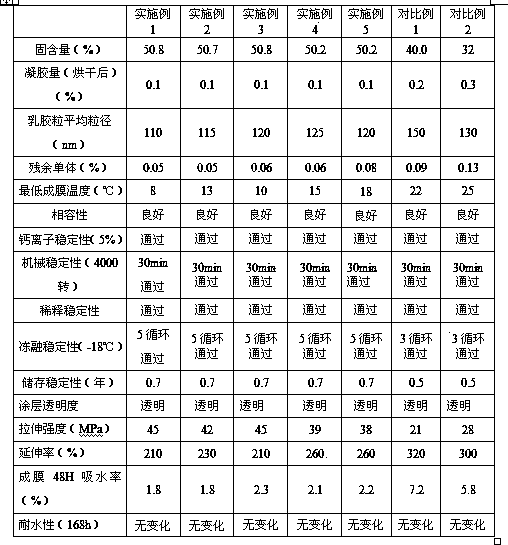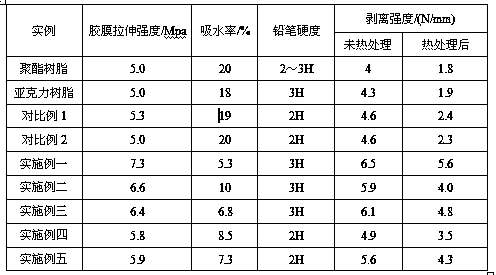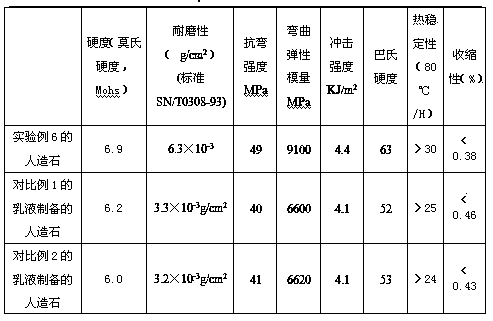Polyurethane modified acrylic emulsion, preparation method of acrylic emulsion and prepared artificial stone
An acrylic emulsion, polyurethane modification technology, applied in the field of artificial stone, can solve the problems of high curing shrinkage, unsatisfactory heat resistance and flame retardancy, poor processing and shapeability, etc., and achieves high molecular weight, good performance and high strength. Effect
- Summary
- Abstract
- Description
- Claims
- Application Information
AI Technical Summary
Problems solved by technology
Method used
Image
Examples
Embodiment 1
[0068] 1) Preparation of hydroxy acrylate emulsion
[0069] 100 parts by weight of water, 5.5 parts by weight of sodium lauryl sulfate, 2.5 parts by weight of nonylphenol polyoxyethylene ether, 30 parts by weight of styrene, 150 parts by weight of methyl methacrylate, 18 parts by weight of butyl acrylate, and acrylic acid Mix 2 parts by weight evenly to obtain a uniform pre-emulsion;
[0070] Add 300 parts by weight of water to the reaction kettle, heat up to 80°C, add 10% of the pre-emulsion, 0.5 parts by weight of the initiator ammonium persulfate, and react for 35 minutes until the blue light is sufficient; add the remaining pre-emulsion and 2.0 parts by weight of the initiator dropwise Ammonium persulfate, the dripping time is 3 hours, and the temperature is kept for 30 minutes after dripping;
[0071] 150 parts by weight of butyl acrylate, 55 parts by weight of methyl methacrylate, 50 parts by weight of hydroxyethyl acrylate, and 5 parts by weight of acrylic acid are mixed unif...
Embodiment 2
[0079] 1) Preparation of hydroxy acrylate emulsion
[0080] Combine 80 parts by weight of water, 2 parts by weight of sodium lauryl sulfate, 1.5 parts by weight of nonylphenol polyoxyethylene ether, 10 parts by weight of styrene, 100 parts by weight of methyl methacrylate, 10 parts by weight of butyl acrylate, and acrylic acid Mix 2 parts by weight to obtain a pre-emulsion.
[0081] Add 260 parts by weight of water into the reaction vessel, raise the temperature to 70° C., add 4% pre-emulsion and 0.2 parts by weight of ammonium persulfate, and react for 15 minutes until the blue light is sufficient. Start dropping the remaining pre-emulsion and 1.2 parts by weight of ammonium persulfate. The dropping time was 2.5 hours, and the temperature keeping reaction was 30 minutes after the dropping. Mix 140 parts by weight of butyl acrylate, 40 parts by weight of methyl methacrylate, 30 parts by weight of hydroxyethyl acrylate, and 10 parts by weight of acrylic acid as the second-step mix...
Embodiment 3
[0088] 1) Preparation of hydroxy acrylate emulsion
[0089] 140 parts by weight of water, 8.5 parts by weight of sodium lauryl sulfate, 6.5 parts by weight of nonylphenol polyoxyethylene ether, 155 parts by weight of styrene, 203 parts by weight of methyl methacrylate, 85 parts by weight of butyl acrylate, and acrylic acid 2.5 parts by weight are stirred evenly to obtain a pre-emulsion.
[0090] Add 320 parts by weight of water into the reaction vessel, increase the temperature to 85° C., add 15% of pre-emulsion, 0.8 parts by weight of ammonium persulfate, and react for 45 minutes until the blue light is sufficient. Start dropping the remaining pre-emulsion and 2.5 parts by weight of ammonium persulfate. The dripping time is 4 hours, and the temperature keeping reaction is 30 minutes after dripping. 160 parts by weight of butyl acrylate, 80 parts by weight of methyl methacrylate, 55 parts by weight of hydroxyethyl acrylate, and 5 parts by weight of acrylic acid were mixed uniform...
PUM
| Property | Measurement | Unit |
|---|---|---|
| tensile strength | aaaaa | aaaaa |
| heat deflection temperature | aaaaa | aaaaa |
| heat deflection temperature | aaaaa | aaaaa |
Abstract
Description
Claims
Application Information
 Login to View More
Login to View More - R&D
- Intellectual Property
- Life Sciences
- Materials
- Tech Scout
- Unparalleled Data Quality
- Higher Quality Content
- 60% Fewer Hallucinations
Browse by: Latest US Patents, China's latest patents, Technical Efficacy Thesaurus, Application Domain, Technology Topic, Popular Technical Reports.
© 2025 PatSnap. All rights reserved.Legal|Privacy policy|Modern Slavery Act Transparency Statement|Sitemap|About US| Contact US: help@patsnap.com



